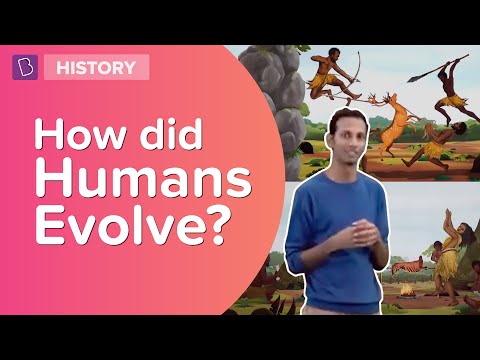Table of Contents
Introduction
Homo sapiens, the most prominent species on earth is the result of over 7 million years of evolution. The traces of human evolution have been obtained through fossil records, and morphological, physiological and embryological studies.
Man belongs to the family Hominidae of the order Primates. Humanlike apes belong to the same order. With the passage of time, their ancestors evolved and became more and more different.
The first-ever ancestors of humans are believed to have originated in Africa, eventually migrating to Europe, Asia and the rest of the world.

Earliest Ancestor
Ardipithecus were one of the earliest ancestors to have been discovered, with fossils dating back more than 4.4 million years old. The details of human evolution are still debated as fossil evidence of many ancestors is quite vague. In fact, instead of the human evolution tree, a more accurate analogy could be drawn to an evolutionary bush.
Charles Darwin never implied the fact that humans evolved from apes, although, many of his fellow contemporaries insisted that he had. Furthermore, the concept of a “missing link” between apes and humans was considered preposterous by scientists because we have evolved alongside the great apes. However, we do have a common ancestor that lived roughly 7 million years ago. Furthermore, evolution points to the presence of “nodal fossils”, meaning that humans evolved gradually, as opposed to a sudden change.
Process of Human Evolution
The evolution process involves a series of changes that cause the species to either adapt to the environment or become extinct. Evolution is the result of changes in the genetic material of humans. It does not change a single organism, but the entire group of organisms belonging to the same species.
Man originated through several stages:
Dryopethicus
It is the earliest known ancestor of man. They were found in some parts of Africa, Asia and Europe. The evolution of man began with him. Dryopethicus was followed by Australopithecus.
Australopithecus
These were 1.2 metres tall and could walk upright. They inhabited the African mainland. They had large jaws and human-like teeth.
Homo habilis
They were five feet tall and could make use of tools. They are believed to have been able to speak.
Homo erectus
They were more evolved beings. They were also upright and had a larger brain size. They had a prominent speech. They invented fire and were carnivorous.
Homo sapiens
These are modern men. They developed the power of thinking, used tools, were omnivorous and produced art. Their brain size was reduced to 1300 cc.
Neanderthals
Homo sapiens is the only extant species of hominin around today, but a few thousand years ago, there were a few other species that existed alongside anatomically modern humans – the Neanderthals, Denisovans and the Homo floresiensis. Today, scientists consider Neanderthals to be more of a subspecies of humans rather than a completely separate species.
To explore more about the evolution of man or other related topics, visit BYJU’S. From in-depth articles to fascinating videos, BYJU’S is a treasure trove of educational resources.
Further Reading:-
| Evidence of Evolution |
| Human Evolution – Evolution Vs Progress |

Frequently Asked Questions – FAQs
Describe the origin and evolution of humans in chronological order.
Australopithecus existed 2 mya. They used stone weapons to hunt.
Then came the first human-like hominid called Homo habilis who had brain capacities of 650-800 cc.
Homo erectus existed 1.5 mya. They had a larger brain (900 ccs) and ate meat.
Neanderthals lived 1-0.4 mya. They used hides to protect their bodies.
The modern man i.e Homo sapiens came into existance 0.75-0.1 mya.
Are evolution and speciation the same?
Speciation
-The formation of new and distinct species in the course of evolution.
Evolution
-The gradual development of something, especially from a simple to a more complex form.

I love BYJU’S that is so much fun. I also study from BYJU’S 🤭🤭🤭🤭🤭🤭🏩
Byju’s is very good it is very useful to me
I love Byjus. From this I can easily understand any topic